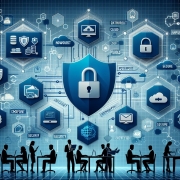

Check Point Harmony SASE and ThreatLocker are competitors in the cybersecurity space, each offering distinct advantages. Check Point Harmony SASE appears to have an edge with its robust security features and excellent customer service, making it attractive for larger organizations.
Features: Check Point Harmony SASE provides split tunneling, Multi-Factor Authentication, and Zero Trust Network Access. It offers enhanced security with data loss prevention, HTTPS decryption, and firewall capabilities. ThreatLocker excels in application control through allowlisting, ring-fencing, and Zero Trust principles. Its learning mode and selective elevation ease operations, alongside cyber threat training sessions.
Room for Improvement: Check Point Harmony SASE could benefit from better third-party integration, a more granular analytics interface, and simpler deployment processes. ThreatLocker needs staggered policy updates, a more intuitive user interface, and improved visibility of support tickets.
Ease of Deployment and Customer Service: Both platforms enable deployment across private, public, and hybrid clouds. Check Point Harmony SASE is praised for its rapid customer service, while ThreatLocker is recognized for its responsive technical support and Cyber Hero feature.
Pricing and ROI: Check Point Harmony SASE is priced higher, aligning with its extensive security capabilities and offering value to larger firms. ThreatLocker offers fair pricing with significant value from its comprehensive security features. Both demonstrate ROI through improved productivity and security, variable by deployment and use.
Check Point Harmony SASE (formerly Perimeter 81) blocked access to those URLs at the network level before users could click through.
We are saving 40% of our time, which is good.
If something were to happen without ThreatLocker, the cost would be huge, and thus, having it is definitely worth it.
The main return on investment is peace of mind, knowing that with ThreatLocker on any endpoint, it will almost always block all malicious code or exploits, even zero-day exploits.
It keeps malware, Trojans, and ransomware at bay.
I would rate support 10 out of 10.
People working really hard, listening to every issue and request, and replying within hours.
They have been very responsive, helpful, and knowledgeable.
I would rate their customer support a ten out of ten.
Their support is world-class.
The cloud-native model ensures we are not tied to any specific location or hardware, which has been a great game changer in terms of agility.
I would rate it nine out of ten for scalability.
Check Point Harmony SASE's scalability is good; it can handle growth easily, allowing me to easily add another region and gateway to have more people join in.
I started off with just the servers, and within a month and a half, I set up the entire company with ThreatLocker.
It seems to primarily operate on the endpoints rather than at a central location pushing out policies.
I would rate it a ten out of ten for scalability.
There are some lags and glitches with connectivity, so I would rate the stability as between seven or eight out of ten.
After the last improvement, I can say it is much more stable now.
Check Point Harmony SASE is stable most of the time, but there are still some issues that are hard to troubleshoot.
For five years, we have not had a problem.
Once deployed, it downloads the policies locally, so even if the computer doesn't have internet, it doesn't matter.
It has been very stable, reliable, and accessible.
A local data center in Turkey would enhance the product, as currently, our Internet traffic goes to another country, which is problematic for us.
One area for improvement is integration with third-party identity providers.
The product is lacking features that other competitors have, making it quite challenging to migrate customers to this solution because it feels very much unfinished.
Controlling the cloud environment, not just endpoints, is crucial.
This is problematic when immediate attention is needed.
Comprehensive 24-hour log monitoring is a valuable enhancement for both business and enterprise-level users.
Cost efficiency is a consideration, as SASE products are not the cheapest security products.
The cost is a bit expensive for most users.
It is a bit expensive.
After conversations with other partners, it became clear we underpriced it initially, which caused most of our issues.
We are moving towards the Unified solution, where they basically bundle everything together, providing us better stability with the ability to bring in new product offerings without having to go back to the customer and say, 'This is going to cost you.'
I had a really good deal at the time, and it continues to be cost-effective.
The firewall management is the most valuable feature for me.
The Zero Trust Network Access (ZTNA) feature is a major highlight as it gives users seamless and secure access to internal resources without requiring a full-blown VPN, which improves both security and user experience.
The Zero Trust and segmentation have helped my team and our customers significantly because we are able to protect every scope and allow the work-from-home users to access internal resources while passing through a threat prevention gateway, ensuring that everything is safe.
ThreatLocker Zero Trust Endpoint Protection Platform's ability to block access to unauthorized applications has been excellent.
It protects our customers.
The major benefit is fewer breaches overall, as nothing can be run without prior approval. This helps my company protect its data and secure itself effectively.
| Product | Market Share (%) |
|---|---|
| Check Point Harmony SASE (formerly Perimeter 81) | 7.0% |
| ThreatLocker Zero Trust Endpoint Protection Platform | 2.3% |
| Other | 90.7% |


| Company Size | Count |
|---|---|
| Small Business | 53 |
| Midsize Enterprise | 18 |
| Large Enterprise | 15 |
| Company Size | Count |
|---|---|
| Small Business | 32 |
| Midsize Enterprise | 4 |
| Large Enterprise | 3 |
Check Point Harmony SASE, formerly Perimeter 81, offers robust security features like split tunneling, MFA, and Zero Trust Network Access focused on secure remote access and optimized connectivity for remote teams.
Check Point Harmony SASE delivers advanced security through a user-friendly interface, efficient VPN connections, and a centralized management console. It enhances security with real-time threat intelligence from ThreatCloud and traffic management via built-in optimization. Firewall as a Service and Secure Web Gateway safeguard against unauthorized access and phishing. While users seek enhanced networking customizations and better integration with identity providers, there's an emphasis on improving reporting, real-time analytics, and policy management. Requests also include a Chrome extension, traffic balancing, and simplified configuration to address some resource-intensive aspects.
What are the key features of Check Point Harmony SASE?
How can organizations benefit from using Check Point Harmony SASE?
Check Point Harmony SASE is used across industries for secure remote access and connectivity, protecting sensitive data, and managing access to corporate resources. It is ideal for those with hybrid cloud models and requires comprehensive security measures combined with existing IT infrastructures to meet specific industry demands.
ThreatLocker Zero Trust Endpoint Protection Platform offers robust endpoint security through application control and allowlisting, safeguarding servers and workstations from unauthorized software execution.
ThreatLocker Zero Trust Endpoint Protection Platform provides extensive application control with features like ring-fencing and selective elevation, ensuring meticulous execution management. Offering learning mode and extensive support, it integrates threat detection and activity monitoring to enhance compliance, reduce costs, and bolster cybersecurity through alerts and approvals. Despite its strengths, there are areas for improvement in training flexibility, policy updates, and interface enhancements, along with challenges in handling non-digitally signed software. Deployed across environments, it works well with existing cybersecurity instruments for real-time threat prevention.
What are the top features of ThreatLocker?ThreatLocker Zero Trust Endpoint Protection Platform is widely implemented to safeguard IT infrastructures against unauthorized access and application use. In sectors where data security is paramount, this platform enables users to prevent unauthorized software installations and control device applications, ensuring real-time threat prevention and compliance with industry regulations.
We monitor all ZTNA reviews to prevent fraudulent reviews and keep review quality high. We do not post reviews by company employees or direct competitors. We validate each review for authenticity via cross-reference with LinkedIn, and personal follow-up with the reviewer when necessary.